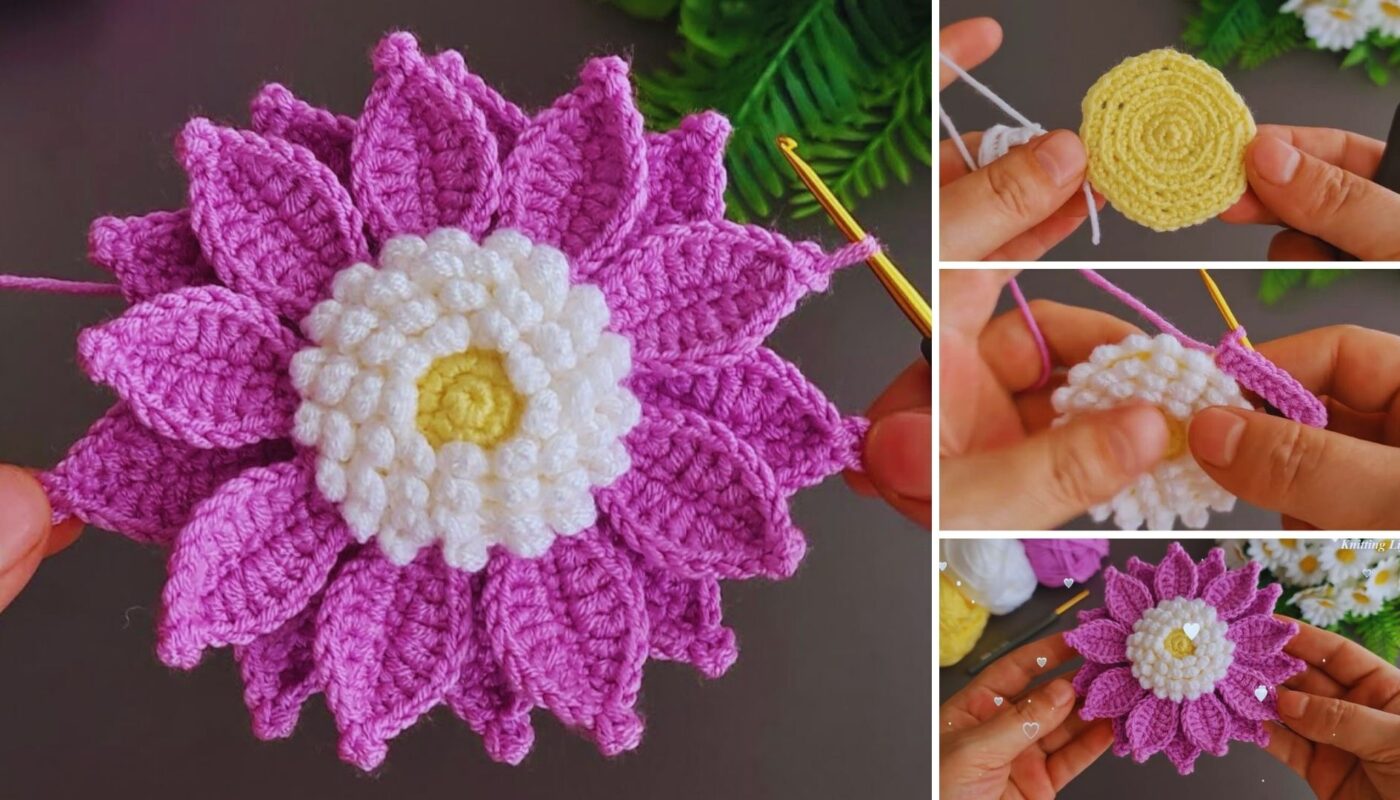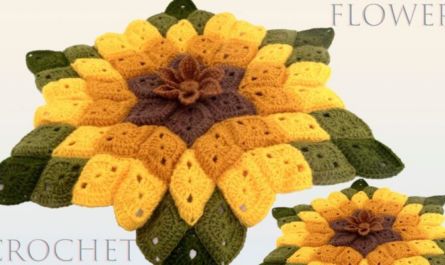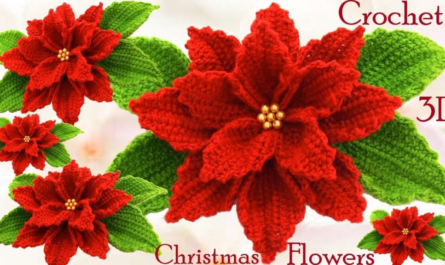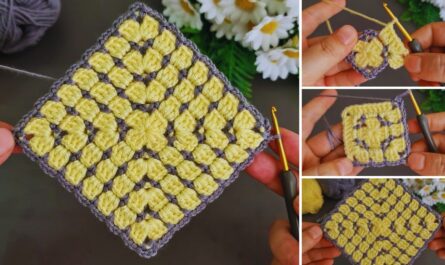Let’s dive into making a truly beautiful, eye-catching crochet flower! This isn’t just a basic flat flower; we’ll focus on creating a multi-layered, dimensional bloom that really stands out, perfect for embellishing hats, bags, scarves, or even as a standalone decorative piece. The key to “eye-catching” is often in the layering, texture, and careful shaping of each petal.
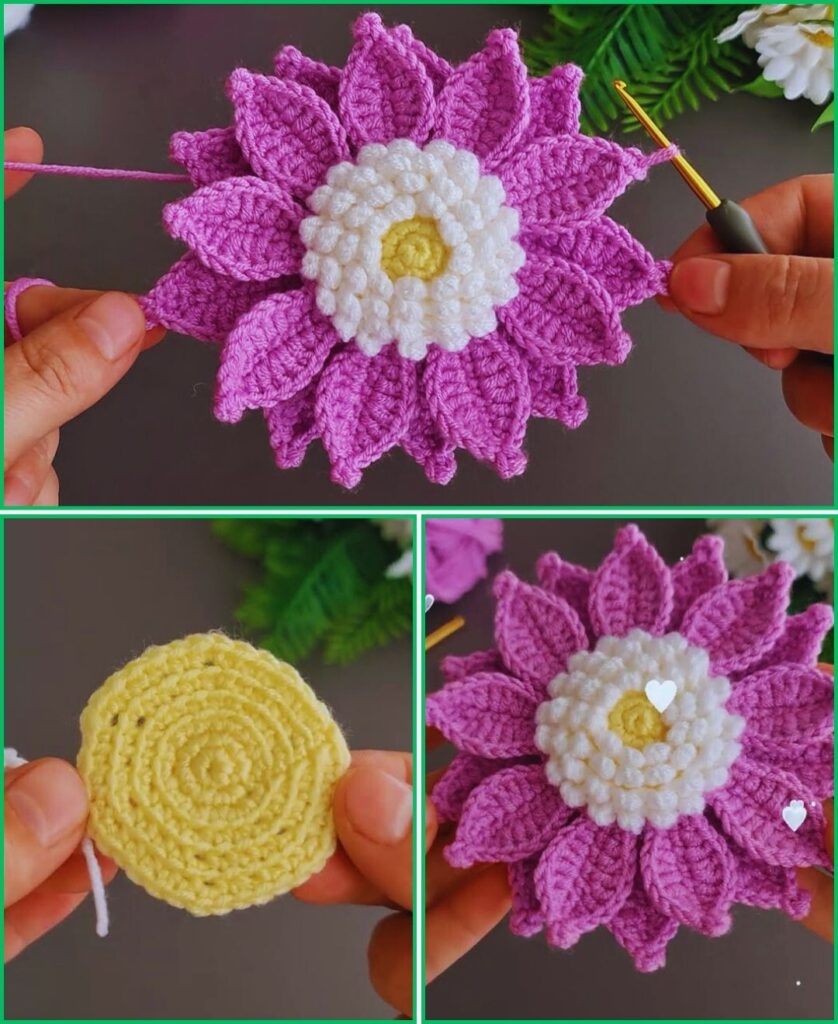
How to Make a Beautiful, Eye-Catching Crochet Flower: Detailed Tutorial
This pattern will guide you through creating a stunning 3D flower, built in layers to give it depth and realistic appeal. We’ll use a combination of simple stitches to achieve a rich, textured look.
Skill Level: Intermediate
You’ll need to be comfortable with:
- Chain (ch): The foundation of crochet.
- Slip Stitch (sl st): For joining and neatening.
- Single Crochet (sc): A compact stitch.
- Half Double Crochet (hdc): A medium-height stitch.
- Double Crochet (dc): A taller stitch.
- Treble Crochet (tr): An even taller stitch (sometimes called triple crochet).
- Working in rounds: Crocheting in a circle.
- Increasing: Adding stitches for shaping.
- Magic Ring (MR) or Adjustable Ring: Highly recommended for a tight center.
- Working into front loops only (FLO) and back loops only (BLO): Crucial for creating layers.
- Working into chain spaces and skipped stitches: For strategic petal placement.
- Weaving in ends neatly.
Finished Flower Dimensions (Approximate):
This can vary greatly based on your yarn and hook, but this pattern generally creates a flower about 3.5 to 5 inches (9 to 12.5 cm) in diameter. You can adjust the size by using different yarn weights and hook sizes.
Materials You’ll Need:
- Yarn: Approximately 20-40 yards (18-37 meters) of Worsted Weight (Medium #4) Yarn.
- Color Choice: You can use a single color for a sophisticated monochromatic look, or choose 2-3 complementary or contrasting colors to emphasize the layers and make your flower even more eye-catching. For example:
- Color A (Center/Inner Petals): A lighter shade or a bright pop.
- Color B (Middle Petals): A slightly darker or richer shade.
- Color C (Outer Petals/Base): A deep, rich color that anchors the flower.
- Yarn Fiber: Acrylic is versatile and comes in many colors. Cotton gives great stitch definition and a slightly stiffer feel, which can be good for holding shape.
- Color Choice: You can use a single color for a sophisticated monochromatic look, or choose 2-3 complementary or contrasting colors to emphasize the layers and make your flower even more eye-catching. For example:
- Crochet Hook: Size H/5.0mm. This is a versatile hook size for worsted weight yarn. If your stitches are too tight, go up a size; if too loose, go down.
- Yarn Needle (Tapestry Needle): Essential for weaving in all those loose ends for a professional finish.
- Scissors: For cutting yarn.
Gauge:
Gauge isn’t critical for a standalone flower motif. However, consistent tension is key to ensuring your petals are uniform and your flower lies well without puckering or ruffling excessively.
Abbreviations Used in This Pattern:
- ch: chain
- sl st: slip stitch
- sc: single crochet
- hdc: half double crochet
- dc: double crochet
- tr: treble crochet (yarn over twice before inserting hook)
- st(s): stitch(es)
- sp: space
- ch-sp: chain space
- MR: Magic Ring (also called Magic Circle or Adjustable Ring)
- FLO: Front Loop Only (work into the loop closest to you)
- BLO: Back Loop Only (work into the loop furthest from you)
- rep: repeat
- FO: Fasten Off
- (): repeat instructions within parentheses a specified number of times.
- []: indicates the total number of stitches at the end of a specific round.
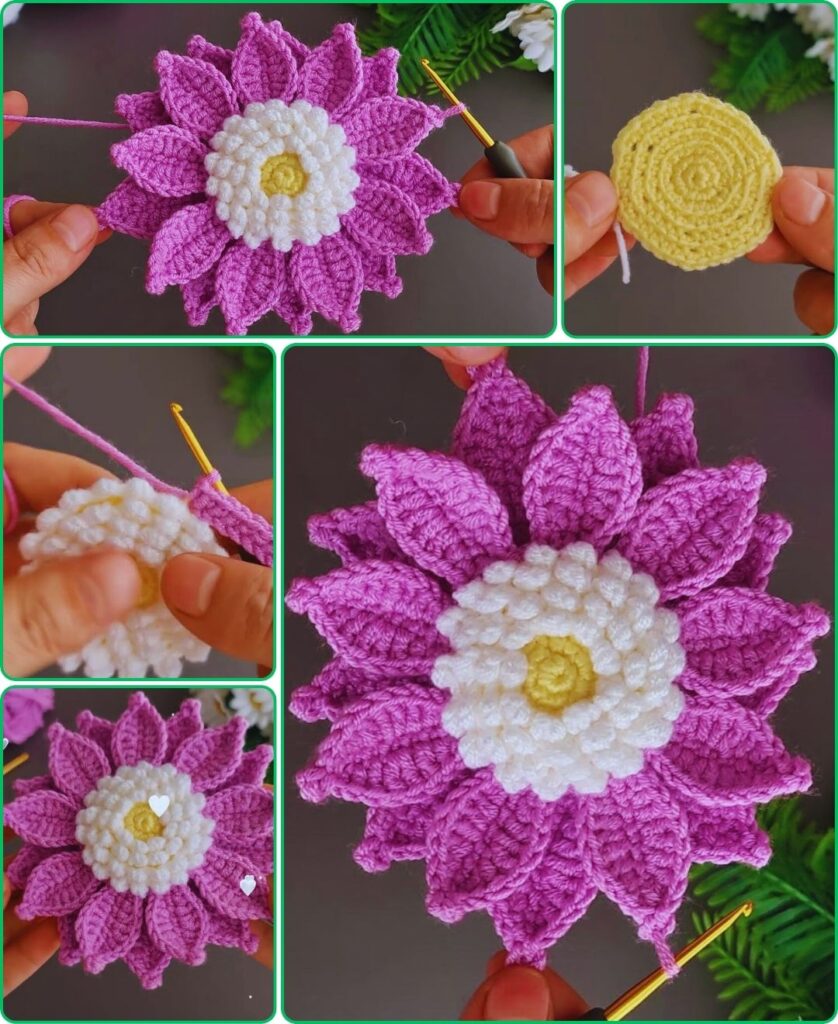
The Secret to 3D Flowers: Layering with FLO/BLO
The magic of a 3D crochet flower lies in how you create new layers of petals. By working into only the front loop (FLO) or back loop (BLO) of a stitch in certain rounds, you leave the other loop unworked. This unworked loop then becomes a ready-made foundation for crocheting a new layer of petals behind or in front of the previous one, giving your flower beautiful depth and dimension.
Let’s Crochet Your Beautiful, Eye-Catching Flower!
We’ll build this flower from the center outwards, creating multiple layers of petals.
Part 1: Flower Center & Base for First Petals (Color A)
- Start: Make a Magic Ring (MR).
- Alternative Start: Chain 4, then sl st into the first chain to form a ring.
- Round 1:
- Ch 1 (does NOT count as a stitch).
- Work 10 sc into the MR.
- Pull the tail tightly to close the center hole.
- Sl st into the first sc to join the round.
- [10 sc]
- Round 2:
- Ch 2 (does NOT count as a stitch, but gives height).
- Work 2 dc into each stitch around.
- Sl st into the top of the first dc to join.
- [20 dc]
- Round 3 (Foundation for petals):
- Ch 1 (does NOT count as a stitch).
- Work sc in the BLO (Back Loop Only) of each stitch around.
- Sl st into the first sc to join.
- [20 sc]
- Fasten off (FO) Color A, leaving a 6-inch tail.
Part 2: First Layer of Petals (Color B)
These will be your innermost petals. We’ll attach the new color into the unworked front loops from Round 2.
- Join Color B: Turn your work slightly so you can clearly see the unworked Front Loops (FLO) from Round 2 (the row of 20 dc stitches).
- Join Color B with a sl st into any FLO of a stitch from Round 2.
- Round 4 (Petals):
- Ch 1 (does NOT count as a stitch).
- *(Sl st into the FLO of the next stitch, ch 2, work 2 dc into the FLO of the next stitch, ch 2, sl st into the FLO of the next stitch).* This forms one petal.
- Repeat from * to * 6 more times around. You will have 7 petals.
- Self-Correction: If your stitches in Round 2 were 20, and each petal takes up 3 FLOs (sl st, 2dc in 1 FLO, sl st), you’ll have some FLOs left. Don’t worry, the next layer will use those. Just ensure your 7 petals are evenly distributed. You might need to occasionally skip an FLO to make the count work.
- After your last petal, sl st into the first sl st you made in this round to securely finish.
- Fasten off (FO) Color B, leaving a 6-inch tail.
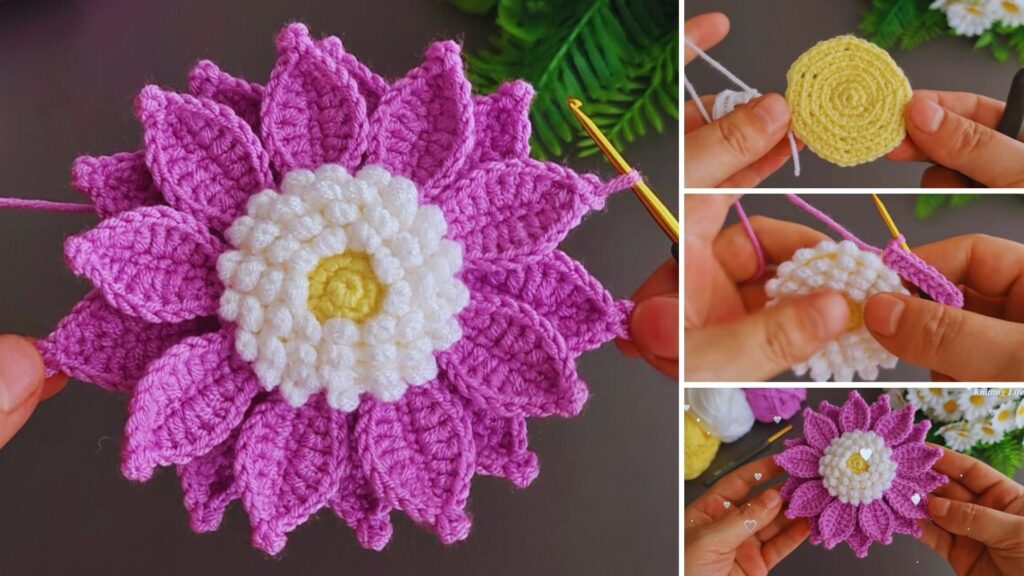
Part 3: Second Layer of Petals (Color C)
Now for the larger, outer layer of petals. You’ll be working into the unworked back loops from Round 2 AND the back loops from Round 3.
- Join Color C: Turn your flower over. You’ll see a distinct ridge of unworked BLOs from Round 2 (behind your first set of petals) and another ridge from Round 3. We’ll focus on the BLOs from Round 3 as our base for this layer, but we will “catch” the Round 2 BLOs for stability.
- Join Color C with a sl st into any BLO of a stitch from Round 3.
- Round 5 (Foundation for outer petals):
- Ch 1 (does NOT count as a stitch).
- Work sc in the same BLO from Round 3 where you joined.
- Work sc in each BLO of Round 3 around.
- Sl st into the first sc to join the round.
- [20 sc] (This base might not be perfectly flat yet, but it forms the foundation for your next layer of petals.)
- Round 6 (Outer Petals):
- Ch 1 (does NOT count as a stitch).
- *(Sl st into the next sc (from Round 5), ch 3, work 1 dc into the next sc, 2 tr into the next sc, 1 dc into the next sc, ch 3, sl st into the next sc).* This creates one large petal.
- Repeat from * to * 3 more times around. You will have 4 petals.
- You will skip some stitches between each petal cluster to create the large petal shape. Aim to distribute them evenly around the 20 sc from Round 5. Each petal cluster uses 4 sc (sl st, dc, 2tr, dc, sl st) so 20/4 = 5 petals. Let’s make 5 petals for this round for consistency.
- Let’s revise Round 6 (Outer Petals) for 5 petals:
- *(Sl st into the next sc (from Round 5), ch 3, work 1 dc into the next sc, 2 tr into the next sc, 1 dc into the next sc, ch 3, sl st into the next sc).*
- Repeat from * to * 4 more times around. You will have 5 petals.
- After your last petal, sl st into the first sl st you made in this round to securely finish.
- Fasten off (FO) Color C, leaving a 6-inch tail.
Part 4: Finishing Your Beautiful Flower
- Weave in All Ends:
- This is absolutely crucial for a professional, durable, and eye-catching finish. Thread each yarn tail onto your yarn needle.
- Carefully weave them into the stitches of the same color on the back side of your flower. Try to go through the middle of the stitches to fully hide the tails. Weave in one direction for a few stitches, then change direction slightly and weave back for a few stitches (this “locks” the tail in place).
- Take your time with this step; it makes all the difference!
- Shape Your Flower:
- Gently lay your flower flat. Use your fingers to manipulate and shape the petals. You can gently curl the tips, arrange them to overlap beautifully, and fluff them out to enhance the 3D effect. The larger outer petals should subtly frame the smaller inner petals.
- For a truly crisp look, a light steam block can be very beneficial. Hover a steamer or an iron (on a low, steam setting) over the flower without touching the fabric. Gently shape the petals with your fingers while they are warm and damp. Allow to air dry completely. This will help the flower hold its beautiful shape.
You’ve now created a truly beautiful and eye-catching 3D crochet flower! This intricate piece is perfect for adding a special touch to almost any project or simply as a standalone decorative item. Experiment with different color combinations and yarn weights to create a whole garden of stunning blooms!
